How Much Chicken Per Lb for Pint Jar
These canning chicken directions work for canning chicken, rabbit, duck, goose, turkey, or wild game birds too. Canned chicken is great for homemade soup or casserole recipes.
The directions and pictures here are for a raw pack, bone-in or boneless chicken. But the recipe card below also includes directions for hot pack, which I now prefer because it has a better quality.
Either way, hot or raw pack…
…when canning chicken, you must use a pressure canner.
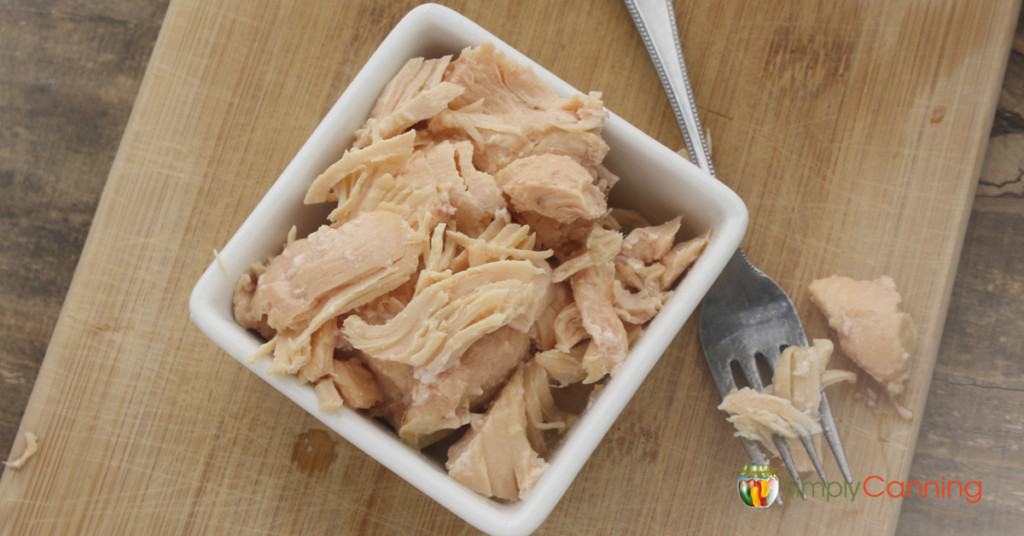
This Page Includes:
- Canning Chicken: Extended, Step-By-Step Directions
- Recipe Card
- {FAQ} Canning Fresh Chicken
- {FAQ} Canning Rabbit
- {FAQ} Is My Canned Chicken Safe to Eat?
- {FAQ} Is Canned Chicken Less Nutritious?
- {FAQ} Clarification on Raw Pack Chicken
- Members' Extra
Canning Chicken: Extended, Step-By-Step Directions
Gather your canning supplies:
- pressure canner
- canning jars
- canning seals and rings
- jar lifter
- canning funnel
- tea kettle or pot to boil water
- sharp knife or kitchen shears
- towels, dish cloths, and potholders
Ingredients:
Chicken – Your choice of boneless or bone-in. Separate meat at the joints. Remove the skins.
Depending on the size of your chicken pieces, quarts will hold 6 or 7 small drumsticks or 5 to 6 thighs. These estimates are bone-in. For chicken breasts, I'd generally estimate about a pound of chicken per pint, 2 pounds per quart. But that is an estimate.
How to Can Chicken
Start by preparing jars and getting water in your canner heating. (See pressure canning for full directions.)
Prepare your chicken for either the raw or hot pack. Separate pieces at the joints and de-bone if you prefer. I can chicken breasts without the bones, but I like canning drumsticks and thighs with the bone in. You can leave skin on or remove it according to your preference. Some say that the skins add flavor.
I don't care for soggy chicken skins, so I remove mine. It still has good flavor!
Raw Pack – Fill your jars loosely with meat pieces, leaving a 1 1/4 inch headspace. Add salt to the jars (1 tsp. per quart or 1/2 tsp. per pint). Do not add liquid.
Hot Pack – Cook the chicken until about 2/3 done. You can boil, bake, or even steam the chicken for this step. I prefer to boil or bake. Fill your jars with lightly cooked chicken, leaving a 1 1/4 inch headspace. Add salt (1 tsp. per quart or 1/2 tsp. per pint) and top off the jars with chicken broth or water.
Packing Tips for Canning Chicken
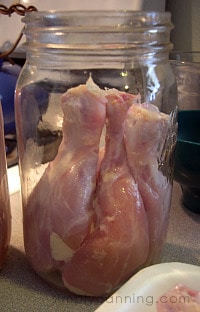
I love canning chicken drumsticks on the bone. I then open the jar to make soups. The bone is so well cooked, it will crumble in my hand. All the the nutrients have gone into the broth. I don't actually use the bone in my soup! (I had someone ask me about that.) But that bone is well done by the time it is cooked.
I truly enjoy serving this to my family.
- For drumsticks, it works well to pack 4 legs with the meaty sides down. Then add 2 or 3 to the top, meaty sides up. This way, the drumsticks nestle together and fill the jar nicely.
- Another packing tip if you want to add water is to pack half the jar and add a little boiling water. Then top the meat off and fill the rest of the jar with hot water or broth. This makes it less likely that you will have large air pockets stuck between your chicken pieces. You'll still need to remove air bubbles. Use that bubble tool, don't skip it.
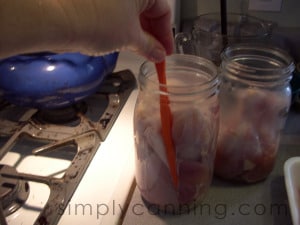
After you have filled your jars, remove any air pockets by sliding a narrow, non-metallic item between the jar and the meat. I like to use an orange peeler. A small spatula or other instrument would work also. Do this even if you've filled half of the way and added water, then filled the jar the rest of the way.
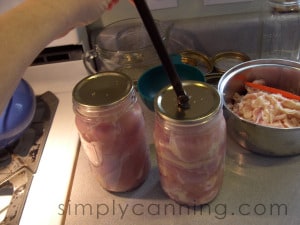
Wipe the rims of your jar clean with a damp cloth or paper towel. This prevents any food particles or grease from interfering with the seal.
Add your lids and screw bands.
Place jars in your pressure canner and process according to pressure canning instructions.
How Long Do You Pressure Can Chicken?
Boneless chicken has a different processing time than bone-in chicken. Be sure to read carefully and get the correct time requirements.
- Bone-In Chicken (Raw Pack or Hot Pack) – Process Pints for 1 hour 5 minutes, Quarts for 1 hour 15 minutes.
- Boneless Chicken (Raw Pack or Hot Pack) – Process Pints for 1 hour 15 minutes, Quarts 1 hour 30 minute.
Make sure and adjust for your altitude using the charts below. For more information on why this is important, see this altitude adjustments page.
Recipe Card
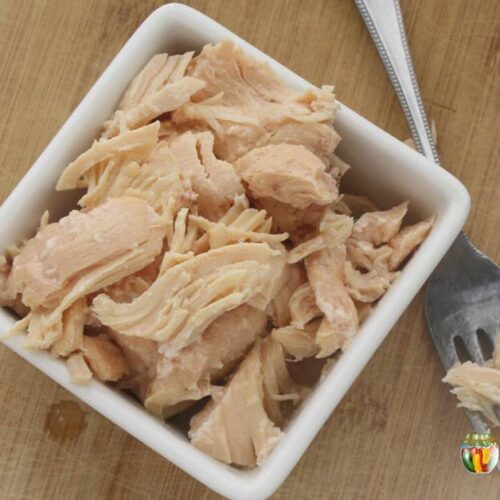
Canning Chicken or Rabbit
Canning Chicken or Rabbit
Course Side Dish
Cuisine American
- Chicken or rabbit (boneless or bone-in)
- Canning salt optional
- Water or broth
-
Start by preparing your jars and getting water in the canner heating. You want the canner hot, but not boiling, when the jars are ready to be processed.
If you are new to using a pressure canner, see this article for full pressure canning instructions. This includes more detailed information and step-by-step instructions on how a pressure canner works.
For a Raw Pack
-
Prepare chicken.
-
Pack raw chicken into hot jars, leaving 1 1/4" headspace.
-
Add salt (1 tsp. per quart or 1/2 tsp. per pint) if desired.
-
Remove bubbles, wipe the rim clean, and place on seal and rings.
-
Place the jar in the warm canner. Proceed to fill all jars. Process according to below directions.
For a Hot Pack
-
Prepare chicken.
-
Simmer chicken until 2/3 cooked.
-
Pack chicken into hot jars, adding boiling water or broth. Leave 1 1/4" headspace.
-
Add salt (1 tsp. per quart or 1/2 tsp. per pint) if desired.
-
Remove bubbles, wipe the rim clean, and place on seal and ring.
-
Place the jar in the warm canner. Proceed to fill all jars. Process according to below directions.
Processing with a Pressure Canner
Place the jars in the warm canner. Proceed to fill all jars placing them in the prepared hot canner.
Put the lid on the canner leaving the weights off. Bring to a boil. Watch for the steam to start coming out the vent pipe in the lid.
Allow the steam to 'vent' for 10 minutes then put the weights on. Use the proper weight for your altitude (check the chart below) This is when pressure will start to build.
When the pressure reaches the pressure required for your altitude (check the chart below) that is when you'll start your time. Process for the full time indicated, adjusting the heat as needed to maintain the correct pressure for the entire time.
When processing time is completed turn off the heat. Do not remove weights yet. Let the canner sit undisturbed until pressure comes back to zero. Do not try to speed up the cooling process.
Remove the weight and wait 5 minutes.
Open the lid to allow steam to escape. (carefully don't let it hit your face or arms!) Leave the lid setting on top of the canner slightly ajar and wait 5 minutes.
Take the lid off the canner and remove your jars. (optionally you can wait another 5 minutes if the contents appear to be bubbling so hard it is coming out of the jars)
Put the jars a few inches apart on a thick towel and allow them to cool to room temperature undisturbed. 12 hours is suggested.
When the jars are cool, remove the metal bands, check the seals, and store the jars in a cool dark place.
Processing With a Pressure Canner
Place the jar in the warm canner. Proceed to fill all jars placing them in the prepared hot canner.
Put the lid on the canner leaving the weights off. Bring to a boil. Watch for the steam to start coming out the vent pipe in the lid.
Allow the steam to 'vent' for 10 minutes then put the weights on. This is when pressure will start to build.
When the pressure reaches the pressure required for your altitude (check the chart below) that is when you'll start your time. Process for the full time indicated, adjusting the heat as needed to maintain the correct pressure for the entire time.
When the processing time is completed turn off the heat. Do not remove weights yet. Let the canner sit undisturbed until pressure comes back to zero. Do not try to speed up the cooling process.
Remove the weight and wait 5 minutes.
Open the lid to allow steam to escape. (carefully don't let it hit your face or arms!) Leave the lid setting on top of the canner slightly ajar and wait 5 minutes.
Take the lid off the canner and remove your jars. (optionally you can wait another 5 minutes if the contents appear to be bubbling so hard it is coming out of the jars)
Put the jars a few inches apart on a thick towel and allow them to cool to room temperature undisturbed. 12 hours is suggested.
When the jars are cool, remove the metal bands, check the seals, and store the jars in a cool dark place.
Processing Times for Bone-In Chicken (Raw Pack or Hot Pack)
Process pints 1 hour 5 minutes or quarts 1 hour 15 minutes , adjusting for altitude.
Processing Times for Boneless Chicken (Raw Pack or Hot Pack)
Process pints 1 hour 15 minutes or quarts 1 hour 30 minutes, adjusting for altitude.
Altitude Adjustments for Pressure Canner
Altitude – Weighted Gauge
0-1,000 ft – 10 pounds
1,001-8,000 ft – 15 pounds
Altitude – Dial Gauge
0-2,000 ft – 11 pounds
2,001-4,000 ft – 12 pounds
4,001-6,000 ft – 13 pounds
6,001-8,000 ft – 14 pounds
Adapted from: The National Center for Home Food Preservation
Last Updated: 5/21/2021
Keyword Canning Chicken, Home Canning, Pressure Canning
Canning Chicken Tips & FAQs
Canning Fresh Chicken
I always can commercially purchased chicken that has already been dressed and chilled.
If you are butchering your own birds or have fresh birds, you should dress them out and chill them for 6-12 hours before canning. I have not found a clearly stated reason why they need to be chilled first, but I did find this note…
Note: Remember that spoilage and disease-causing microorganisms thrive on meats and poultry. Following the four "C's" (clean, chill, don't cross contaminate, and pressure can properly) is critical to producing safe, high quality canned meats. Source: Clemson Edu.
Editing to add: A reader offered this reason for the chilling step when canning fresh chicken. And it makes good sense. Thanks, Patricia!
"Chilling fresh killed poultry or game is to let the rigor mortis settle or relax in the meat. (I was raised on a ranch.) Canning or even cooking meat that is fresh kill and not chilled causes it to be tough or elastic. So it is important to chill all fresh meat 6-12 hours before canning."
Meat is a place where microorganisms would thrive. Fresh meat needs to be processed and stored with care, so follow all instructions. Be sure the meat has been chilled for 6-12 hours.
And here's a tip: A larger bird will have better flavor for canning. You can process fryers, but the bigger chickens are a better quality
Canning Rabbit
If you raise meat rabbits and want to can rabbit, you'll follow the same instructions on this page with the addition of a salt water soak. Soak dressed rabbits in a saltwater solution (1 tablespoon of salt to one quart of water). Rinse and proceed with canning instructions.
I can't seem to get past that cuteness factor! I suppose if I'm starving, I could do it. But for now, I'll stick with chicken. 🙂
Is My Canned Chicken Safe to Eat?
Question:
"I canned cooked cubed chicken today and I didn't have quite enough to fill that last two quarts up to the inch headroom. They were probably about 1 1/2 inches below the top. I filled each quart with boiling water and processed it for 90 min. Now that they have settled it looks like the jars are only a little more than half full of meat, plenty of water though.
My question is this: Will they be safe to eat? Everything sealed fine I'm just wondering if the lower level of food will affect the shelf life somehow.
Thanks for any help.
Carol"
Answer:
Hi Carol,
Yes, as long as the jars sealed and you used the correct pressure for your area, your chicken should be just fine! It is good that you added the liquid to the correct headspace. It sounds as if you did it just right!
Is Canned Chicken Less Nutritious?
Comment:
"My husband is slaughtering 26 chickens today, and for the first time I'm thinking I'd like to can some of the meat/broth. I've always froze them whole before, and then used them as a three night dinner/stock source. Thinking I'd like to can breasts/drumsticks/thighs/and stock. A couple questions.
Will I be limited with soups/stews/casseroles if I can the meat (I've heard it is tender and delicious)? Does the nutrient value of the meat and stock go down after canning chicken? I use bone broth as a healing food for my family. Is the mineral value depleted at all? Thank you so much in advance! love this page!"
Sharon's Addition:
Remember, if you can it first, it is more suitable for casseroles, etc. It is not like you can open it up and eat it like fried chicken. However, it is perfectly good to just eat it as it is. I'll open up a jar and heat it up and serve.
Canning chicken does take away some nutritional value. I have not done extensive research on this, but it is still WAAAAYYY healthier than the stuff you get at the grocer. 🙂
Clarification on Raw Pack Chicken
Adding liquid is optional for raw pack. Ball Blue Book states to add liquid if desired, but the NCHFP does not add liquid to raw pack. You can use either plain water or broth.
Related Pages

Canning Meat
Canning meat allows you to create shelf-stable food for emergencies or quick meals!
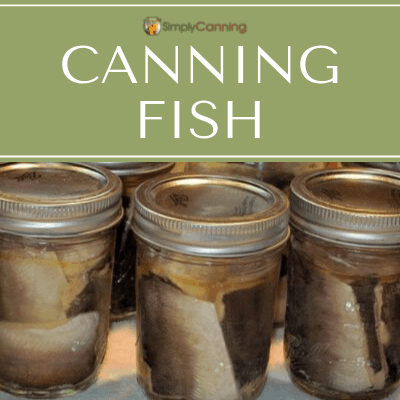

Ground Venison
Home canned ground venison can be used for tacos, chili, casseroles, and more.
Pin This to Find Later:
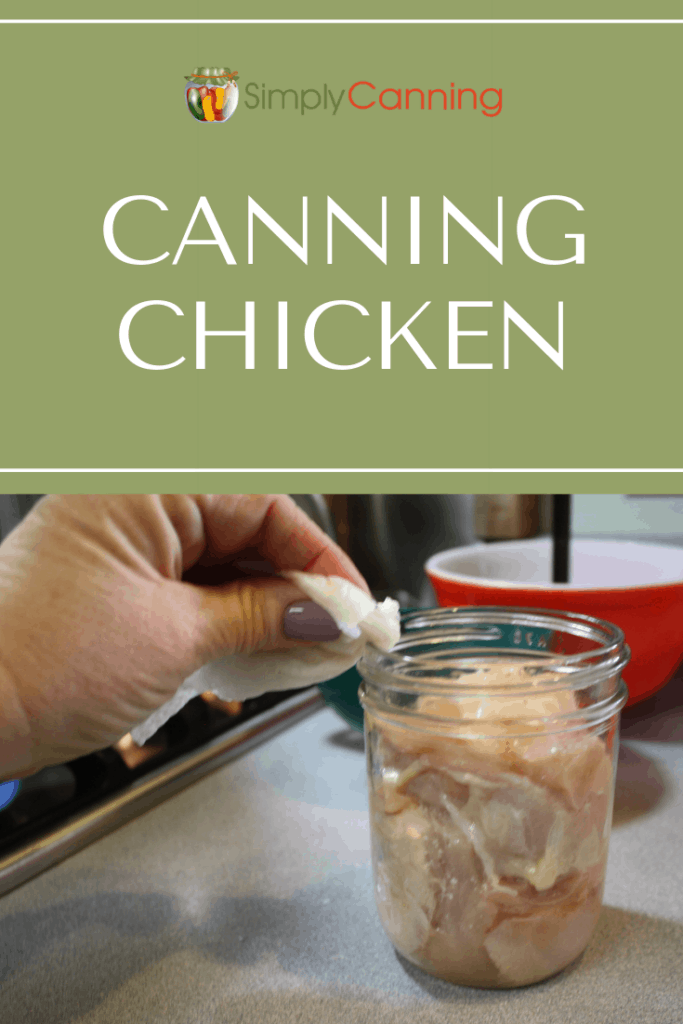
Members' Extra: Access Your Video Tutorial in Your Members Area
Canning school members, click here to log in.
Source: The National Center for Home Food Preservation
Page last updated: 7/8/2021
How Much Chicken Per Lb for Pint Jar
Source: https://www.simplycanning.com/canning-chicken/
0 Response to "How Much Chicken Per Lb for Pint Jar"
Post a Comment